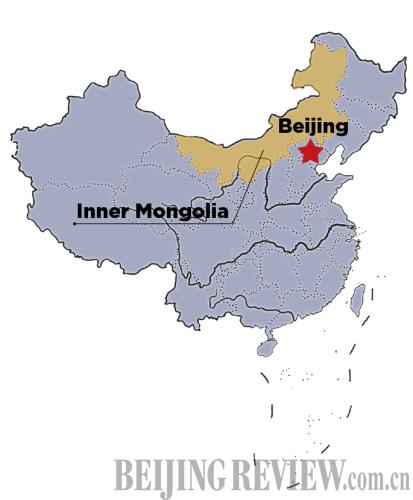|
"This is key for our future development. It's equally important for upgrading the development mode of the resource sector," said Wei.
Inner Mongolia sets the goal that non-resource industries should account for more than 50 percent of the industrial sector, with strategic emerging industries accounting for more than 8 percent. In the future, non-resource industries should become the pillar for regional economic development, according to the Information Office of Inner Mongolia.
Nurturing the service sector is also considered a breakthrough for the region's transformation. "In the next five years, we will raise the output value of the service sector from the current 30 percent of the regional total to 40 percent, which can bring us more added value," said Wei.
Inner Mongolia has enormous potential to develop its service industry. The Chinese Academy of Social Sciences divides China's provinces, autonomous regions and municipalities into three tiers according to their per-capita GDP. The first tier embraces three municipalities, namely Tianjin, Shanghai and Beijing, whose per-capita GDP has surpassed 80,000 yuan ($12,680). Inner Mongolia, whose per-capita GDP stood at 57,515 yuan ($9,116) in 2011, belongs to the second tier. Besides Inner Mongolia, all other members of the second tier are east China's coastal developed provinces, which are renowned for their leading position in the service sector.
"Inner Mongolia is used to relying on natural resources. Transforming the economic development pattern is like making a U-turn in a small alley, which is quite difficult. It needs wisdom and time," said Wei.
In spring, winds often carry sands from Inner Mongolia to other parts of north China. The frequency of these sandstorms has increased as desert limits expand on the heels of environmental deterioration.
Due to the unique geographical position, Inner Mongolia is considered a frontline region for the ecological defense of north China. In 2011, the State Council enacted a document to ensure Inner Mongolia's status as an important ecological barrier.
"When developing the economy, we have the concept that 'environment comes first and ecology is the base.' We have a firm hand on ecological protection and construction," said Wang Yuming, Vice Chairman of the People's Government of the Inner Mongolia Autonomous Region.
Inner Mongolia has set stricter regulations for corporate environment protection responsibilities. The Yuntong Nonferrous Metal Co. Ltd., located in the city of Chifeng, processes copper. Nonferrous metal processing companies are usually major polluters and energy depleters in China. However, in the factory of Yuntong, visitors find neither sharp odors nor waste gas emitted into the air.
"From 2005 to 2008, we carried out technological renovation in line with the requirements of the autonomous regional government," said Han Zhi, General Manager of Yuntong. "Now, all the waste gas, water and residues can be recycled and reused."
Inner Mongolia also gives generous incentives to protecting its grasslands. Last year, the region provided 5 billion yuan ($792.5 million) in subsidies to restore 1 billion mu (666.7 billion square meters) of grasslands. Each year, it also plants numerous trees and nurtures shelter belts to combat the encroaching desert.
The region now has the largest area of forests and grasslands in China, covering 355 million mu (236.7 billion square meters) and 1.32 billion mu (880 billion square meters) respectively.
"Inner Mongolia has made the biggest contribution nationwide in fighting against desertification, increasing carbon sinks, maintaining water and soil and purifying the air," Wang said proudly.
In a bid to tackle desertification, Inner Mongolia has relocated residents in desert areas to regions with a better ecological environment, a process that began in the 1990s. It has also treated desert areas by planting trees and grass.
During the past decade, hundreds of thousands of residents have been relocated to more people-friendly areas.
"The reality shows that ecological immigration is an effective way to combat poverty in areas with a harsh ecological environment. It plays a huge role in helping herdsmen get out of poverty, as well as curbing ecological environment degradation," said Wang.

Email us at: lanxinzhen@bjreview.com | 